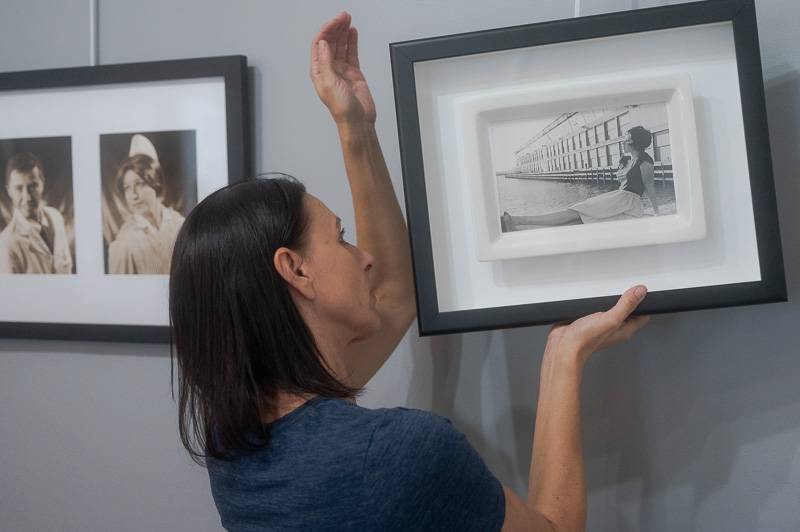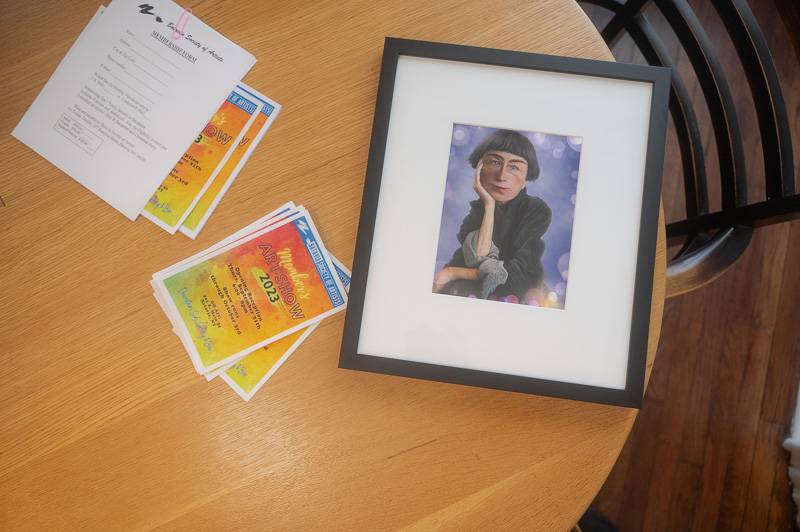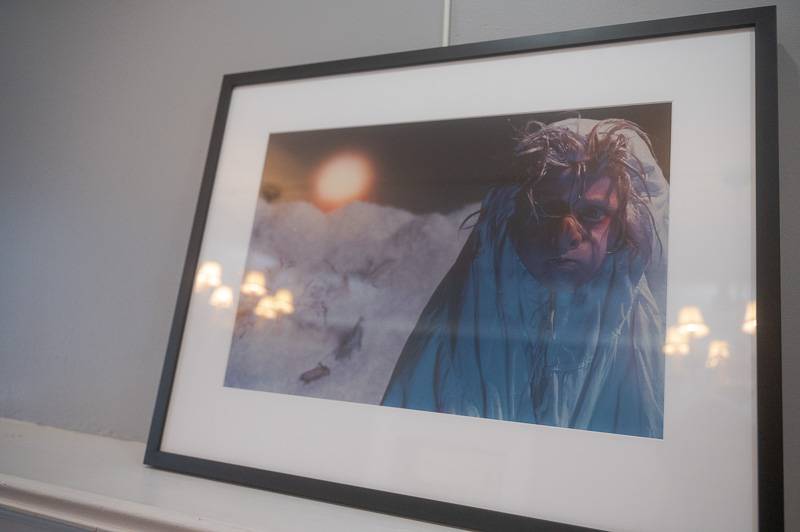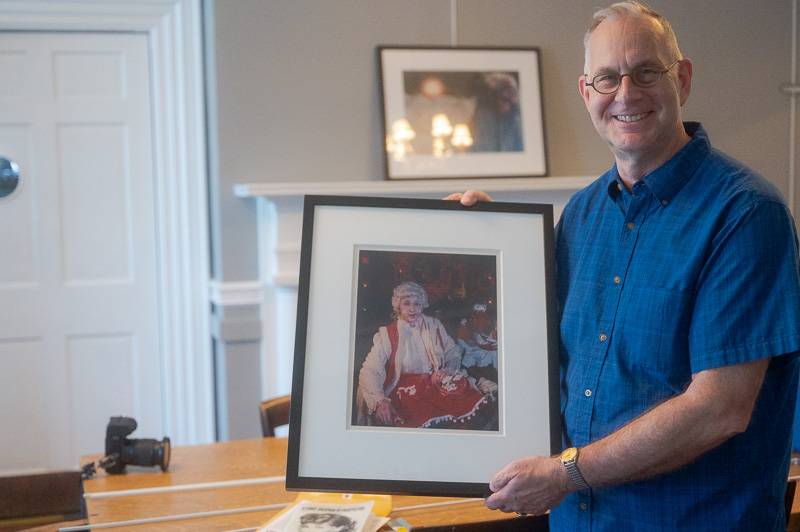
Photo by Howard Owens.
Google "most important living artists," and Cindy Sherman is on that list.
In fact, in 2013, she was touted as one of the six great living artists.
Some of her works have sold for millions, setting records for photographic prints.
That notoriety helps make Sherman interesting to Gerald Mead, who has acquired 23 of her pictures, but that's only, at best, half the reason he collects her work. Mead's interest in Sherman is both parochial and personal. Sherman and Mead both attended Buffalo State University (though about a decade apart), and Mead's passion and specialty is collecting the works of Western New York artists.
He has more than 1,700 pieces in his collection.
"She's really kind of an icon in Buffalo," Mead said. "Her name is known far and wide as one of the most significant photographers, and she has that connection to Western New York. I was really familiar with her whole body of work, and because I was a curator at the Burchfield Penny, we had her works in our collection. It just became a special interest of mine when I first started collecting."
Over the next six weeks, art lovers from the area won't need to travel to London, Paris, Venice, Amsterdam, Los Angeles, San Francisco, New York City, or even Buffalo, to see examples of Sherman's work. They can just take a little trip to GO ART! at 201 East Main St., Batavia, to see a portion of Mead's collection on display.
The show's run starts today (Wednesday) and concludes on Nov. 25, with an opening reception from 5 to 8 p.m. on Oct. 19.
The show is a real coup for GO ART! said Mary Jo Whitman, education/SCR director for the arts council. She wrote her master's thesis on Sherman.
"I'm very excited to get to know a lot of people in this area who don't always get to travel out to the bigger museums to see this kind of work will get to see it," Whitman said. "It's exciting to be able to bring these works to people, essentially."
Whitman said Sherman's work is important to her because it speaks to her in a personal way, because in her work, Sherman presents herself as a chameleon, taking on different roles as the main subject of most of her photos.
Sherman started her rise in prominence with what is still probably her most famous body of work, Untitled Film Stills.
The series was created mostly between 1977 and 1980, mostly in New York City, with the city as a backdrop, or in her apartment. The black and white prints mimic the kind of studio publicity shots that were once produced for film noir or French avante-garde movies. Sherman conceived of the shots -- only a few directly inspired by actual movies -- created the costumes, did her own makeup, and created the pose that seemed to capture the movie's star at a pivotal plot point.
"I felt this immediate connection with her," Whitman said. "I think it's really this idea of, you know, the constructed identity that you can be so many different people. You're in social situations, you're in professional situations, and that kind of really dictates who you are at that moment and really how many different people you can be. I know, for myself, I feel that way. I grew up in a very small town as a country girl, and I went on to be an artist, I can be a crazy hippie at times, and I can be in galleries like this as the pretentious curator. So I play a lot of different roles. I think that I just kind of felt a kinship with her after seeing her work.
After Untitled Film Stills, Sherman moved on to other series that, again, feature her in various roles and characters, such as Fairy Tales, Disasters, Centerfolds, History Portraits, Clowns, and most recently, Instagram Portraits
Mead, whose collection started with "Letraset Art Sheet #1," a collage Sherman made from British clip art in 1966, which he won as a door prize at an afterparty in 1995 for the 20th Anniversary of Hallwalls Contemporary Art Gallery (which Sherman co-founded while at Buffalo State), said his goal has been to collect something of Sherman's from each of her eras and from each decade of her career.
"I've been able to do that over the course of 35 years," Mead said.
Sherman's work appeals to him, Mead said, for that same chameleon character that inspired Whitman to study her work.
"She's used herself as the subject, but she's converted and transformed herself into personalities, personas, characters," Mead said. "She doesn't consider them portraits of people generally because she's the subject of all of them. I think it can be fascinating to see how a person can use their own appearance and alter it to have such a wide spectrum of, again, personalities, personas characters."
Also, Mead said, each photo tells a story that also allows the viewer to help fill in the narrative.
"What's interesting about her work, too, is that it's meant to sort of evoke a response or a reaction because the person in it -- they're all actors or actresses, right? Is just being caught mid-performance. So when you're looking at it, you have to get out it, 'what happened before? What's going to happen right after?' She's telling the story. The interesting thing is, a lot of times, I think people sometimes look to see what the title is to figure out what exactly is going on, but they're all untitled. She intentionally has no title on them because she wants you to bring your own understanding and your own kind of reaction to it."
It's that nuance of story and character that is one reason people should come to see Sherman's work while its on display at GO ART!, Whitman said.
"It's just really cool," Whitman said. "She's got a great idea that's really unique. I mean, she plays all the roles. She is the artist. She's the model. She's the makeup artist. She's creating the work all based on herself. There's all these different guises that she has. It's really fascinating when you kind of break it down to what it took to make each individual work. You're gonna come in, and you're gonna see what looks like a portrait to you, but when you kind of break it down, like okay, this is her in every single portrait, and you will be able to tell it's the same person. So, it's just impressive."
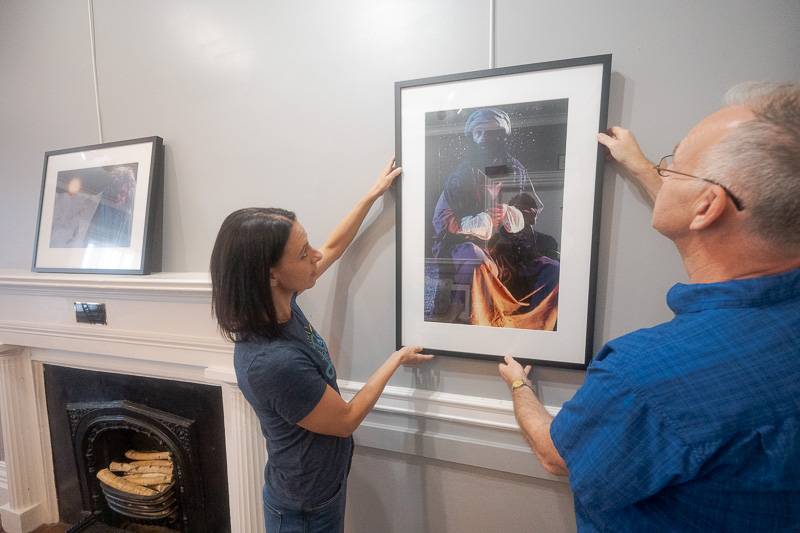
Photo by Howard Owens.

Photo by Howard Owens
